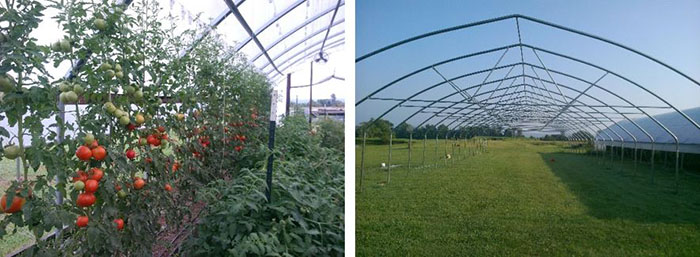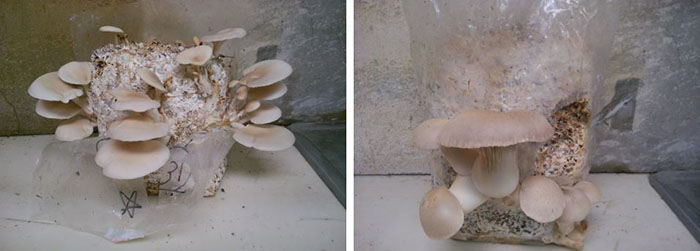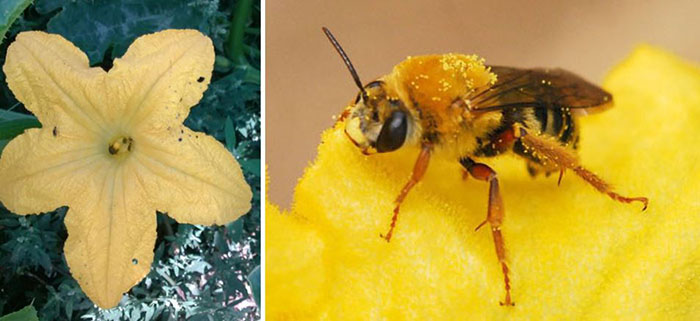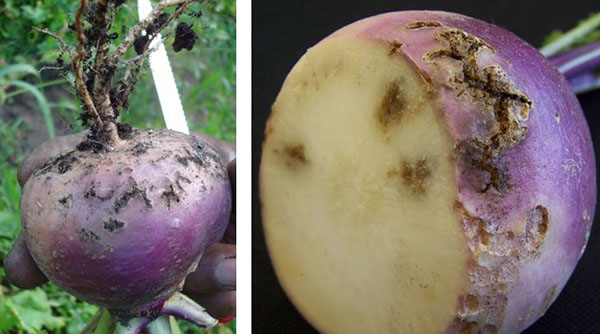"We are what we repeatedly do. Excellence, then, is not an act, but a habit." --Aristotle
Address any questions or comments regarding this newsletter to the individual authors listed after each article or to its editor, Rick Weinzierl, 217-333-6651, weinzier@illinois.edu. To receive e-mail notification of new postings of this newsletter, call or write the same number or address.
In This Issue:
Upcoming Programs (for beginning and established growers)
Regional Reports (from Dixon Springs and southern and western Illinois)
Fruit Production and Pest Management (quick note on codling moth)
Vegetable Production and Pest Management (pumpkin pollinator protection, root maggots in turnips, con earworm update)
Upcoming Programs
Check the Illinois SARE calendar for a full list of programs and links for registration.
http://illinoissare.org/ and http://illinoissare.org/calendar.php
Also see the University of Illinois Extension Local Food Systems and Small Farms Team's web site at:
http://web.extension.illinois.edu/smallfarm/ and their calendar of events at http://web.extension.illinois.edu/units/calendar.cfm?UnitID=629.
- Pumpkin Field Day, September 4, 2014. 10:00 a.m. at the Ewing Demonstration Center, Ewing, IL (about 20 minutes south of Mt. Vernon; 4 miles east of I-57. ½ mile north of the Ewing Northern School off of Main Street) For more information contact Nathan Johanning at 618-687-1727 or njohann@illinois.edu.
- Cover Crops, Soil Health, and Value Adding with Diversity, September 4, 2014. 9:00 a.m. to noon, PrairiErth Farm, Atlanta, IL. For more information, see http://web.extension.illinois.edu/units/event.cfm?UnitID=629&EventID=66230.
- Northwestern IL Farm Tour, September 10, 2014. 6:00 - 7:30 p.m., Agritourism with Pumpkins and Apples, Dittmar Farms and Orchard, Elizabeth, IL. Free and geared towards beginning and experienced growers. Pre-register at http://web.extension.illinois.edu/jsw/; maps to the farms are available at this site. For more information, contact Grant McCarty (gmccarty@illinois.edu) or at 815-235-4125.
- Southern Illinois Summer Twilight Meeting Series, September 15, 2014. 6:00 to 8:00 p.m. On farm program at Lipe Orchards, Carbondale, IL. Pre-registration (at no cost) is required; see http://web.extension.illinois.edu/ghhpsw/ or contact Bronwyn Aly at 618-382-2662 or baly@illinois.edu..
- Meet The Buyer/Meet The Farmer & Overview Of Micro-Food Hub, September 30, 2014. 2:00-3:30 p.m., Champaign County Farm Bureau , 801 N. Country Fair Drive, Champaign, IL. RSVP by September 28 to (217) 352-5235. Farmers wishing to meet retail grocery store, catering, restaurants and foodservice distributor buyers are invited to attend. Program will include preliminary details of the new Micro-Food Hub located in Rantoul, IL.
- Fruit and Vegetable Farmer Cooperative, October 14, 2014. 7:00 p.m., Rantoul Business Center, 601 S. Century Boulevard, Rantoul, IL. RSVP by October 13 to (217) 352-5235. The Illinois Farm Bureau, Champaign County Farm Bureau, and the Village of Rantoul invite area farmers to a fruit and vegetable cooperative meeting. This is a preliminary meeting with plans of forming a fruit and vegetable cooperative for East Central Illinois.
- 2014 Local and Regional Food Summit, November 13, 2014. 9:00 - 5:00 p.m., Heartland Community College, Astroth Community Education Center, 1500 West Raab Road, Normal, IL. Hosted by the Illinois Farm Bureau, Illinois Department of Agriculture and Heartland Community College. Conference registration fee is $20 per participant and includes all conference materials, lunch, and breaks. Register at http://www.ilfb.org/ifb-news-and-events/conferences-events/2014-local-and-regional-food-summit.aspx. Speakers will include industries such as retail grocery, foodservice distribution, university foodservice, food hub, energy alternatives, specialty crops, meat processing, dairy, value-added products, community supported agriculture and more. Register in advance; space is limited. A special Meet the Farmer/Meet the Buyer event for farmers and buyers will take place between 3:15 pm and 5:00 pm for farmers attending the Summit.
- Preparing a New Generation of Illinois Fruit and Vegetable Farmers, December, 2014 - November, 2015. Aspiring farmers, new growers with less than five years' experience, commodity farmers interested in diversifying to include fruit or vegetable production, and high school and community college agriculture teachers are invited to apply for the next session of a free training program offered by the University of Illinois at Dixon Springs, Urbana, and St. Charles, IL. For more information, see http://newillinoisfarmers.org/ and http://news.aces.illinois.edu/news/new-illinois-farmers-program-accepting-applications-third-session.
- Angelic Organics Learning Center is offering the 2014-15 Stateline Farm Beginnings course. The winter course (October through March) provides ten business planning sessions; additional training events (April through October) include monthly field days and advising from established farmers. See http://michaelfields.org/wp-content/uploads/2014/06/Stateline-Farm-Beginnings.pdf..
- Mark your calendars ... for the Illinois Specialty Crops, Agritourism, and Organics Conference, January 7-9, 2015, at the Crowne Plaza Hotel and Convention Center, Springfield, IL.
Regional Reports
At the Dixon Springs Ag Center ... Most growers are at or near completion of their tomato harvest for the 2014 season, and production in high tunnels was very good overall. The only consistent anomaly for extreme southern Illinois growers was less than ideal flavor and quality on fruits harvested early from the first cluster. The lower eating quality seen in the first cluster this year was likely due to the large number of overcast days rather than nutrition or temperatures, as it was seen across growers using soil beds as well as hydroponic production and also in both heated greenhouse production as well as unheated high tunnels. The good news is that this problem resolved itself as growers harvested later maturing fruit, and yield and quality were both reported as very good once we got beyond the first cluster.

Left. Tomatoes in the DSAC high tunnel. Right. Our new high tunnel under construction.
Construction of a third high tunnel is underway at DSAC. Current plans are to devote this 34' x 96' tunnel to hydroponic research and demonstration activities. Additionally, steel end wall kits are going to be installed in the two high tunnels already in place here. This addition will increase both aesthetics and function of the tunnels. The new tunnel was purchased as part of an Illinois Department of Agriculture Specialty Crops Block Grant awarded to Dr. Sam Wortman and myself, and the end wall kits are being purchased with funds made available by gifts from the Illinois Vegetable Growers Association and the Illinois Specialty Growers Association. We appreciate all of our sponsors and partners and want to give a special thanks to both the Illinois Vegetable Growers and Illinois Specialty Growers Association.
Harvest of mushrooms continues as we learn more about pros and cons of small scale mushroom production. In addition to the elm oyster mushrooms that have been shown in previous editions of this newsletter, we are also working with Pearl and King oyster mushrooms..

Pearl and King oyster mushrooms.
Jeff Kindhart (618-695-2770; jkindhar@illinois.edu)
In southern Illinois ... Our recent weather has been a not-so subtle reminder that indeed it is still summer, with highs the last week in the mid-90s and plenty of humidity to go with that as well. We are forecast to get a little "break" from some of the heat and humidity soon, but temperatures are still to stay around 90 for a while.
We are nearing the end of peach harvest, and overall most growers that did have a peach crop were pleased with the quality. Personally, having eaten my way through the various peach maturities from "pre Red Havens" through Lorings and other later varieties, I would have to say that the crop quality throughout the season was very good!. Apple harvest has started with Gala, Golden Supreme, and other early varieties, and harvest of early Jonathan apples will after Labor Day. The apples have enjoyed the overall cool summer, however many growers are worried about sunburn, especially on the reds, with the recent hot weather we have had. Also, table grape harvest is underway, and I've encountered some very tasty grapes available at local markets.
Pumpkins have been progressing well, and the recent warm weather has been pushing growth and ripening. The heat and humidity have also been ideal for disease development, and I have seen and heard many reports of powdery mildew at varying stages of development in pumpkins, so make sure to scout fields and make protectant fungicide sprays to keep you crop healthy. Refer to the Midwest Vegetable Production Guide for more specific details on products to apply, and also make sure to rotate with fungicides with different modes of action to prevent buildup of fungicide-resistant strains of the pathogen. In tomatoes, early blight has been very prevalent, especially with some heavy rains within the last couple of weeks.
At home my fall broccoli crop is looking good, especially with the cool temperatures we have had up until recently.. The plants are just starting to form a head. I have had to manage insects, especially imported cabbage worm, but so far I seem to have them more or less under control.
Looking forward to seeing everyone at Pumpkin Field Day Thursday Sept 4!
Nathan Johanning (618-939-3434; njohann@illinois.edu)
From western Illinois ... As usual, the weather has been the biggest factor for growers in the Quincy area. Since the first of August, we've recorded just shy of 7" of rain, with precipitation occurring on 13 of the first 25 days of August (according to the weather station at the Quincy Regional Airport). There hasn't been a lot of sunshine to allow photosynthesis to occur in plants, and many are commenting on the lack of maturity. Of course, the nearly record setting cool of July didn't help either. I sure don't want to complain about all this moisture, with so many others needing rainfall. I think the last time we had such a green landscape in August was in 2009. And we don't want a repeat of that fall!
The weather has caused numerous problems for growers, including cracking and splitting of fruit (tomato and cantaloupe), increased need for fungicide protection due to constant rainfall/humidity, high levels of fungal leaf diseases in outside tomatoes and other crops, and a delay in fruit maturity in many crops. The uptake of so much water is affecting crops such as cantaloupe and melon, which have lost some of their flavor.
The high humidity of August has allowed for an escalating problem of leaf mold in high tunnel tomatoes. I've also noted that several high tunnel growers are having issues with white core in tomatoes the past couple of weeks. I've always thought that white core was mainly a potassium issue. I'm wondering if the cloudy weather which slowed down plant maturity had any implications with potassium uptake by the plant. Bacterial and fungal disease issues are common on field grown tomatoes.
Powdery mildew of pumpkin is fairly widespread. This is a fungal disease that benefits more from high humidity than actual rainfall. Most fungal diseases thrive under wet conditions, as they require free moisture. Powdery mildew spores are washed off the leaf by rain, and instead require only high humidity levels to germinate.
Cercospora blight in asparagus has been evident for several weeks now. Look for oblong lesions with tan to gray centers and a brown colored border. They will appear on the needles and ferns. If environmental conditions that favor this disease remain, and the disease is left untreated, the entire fern can be affected. The resulting early decline of the plant reduces the amount of food resources that are produced and stored in the crown, resulting in reduced yields next season. Several fungicides are labeled. See the Midwest Vegetable Production Guide for specific details.

Cercospora blight of asparagus.
Planting of fall plasticulture strawberries has begun. We planted on August 23, and for us it's the earliest we've been able to plant. We're hoping that the extra week will allow the plugs ample time to develop enough branch crowns necessary to make the crop better yielding as an annual system. According to Andy and Bill McNitt, the tips arrived from Canada earlier than normal, and the cool July allowed the tips to root and grow in a relatively unrestricted manner.
Mike Roegge (217-223-8380; roeggem@illinois.edu)
Fruit Production and Pest Management
Just a reminder ... codling moth season (and the need for control) is not over. Counts of codling moths in our traps at the University of Illinois Fruit Research Farm at Urbana have increased significantly in the last 10 days or so. As eggs laid by moths over the last few days hatch, larvae will enter fruit and infest it at harvest. Continued management of codling is necessary. The previous issue of this newsletter listed preharvest intervals for insecticides that are effective for codling moth control.
Rick Weinzierl (217-244-2126; weinzier@illinois.edu)
Vegetable Production and Pest Management
Pumpkins and Pollinators
(Obviously) pumpkins set fruit only if female flowers are pollinated by insects. And fruit quality is enhanced by frequent visits by pollinators. Several days ago I was in a field of pumpkins that was literally buzzing with activity. We counted six different pollinators working diligently in this field (well, that included cucumber beetles and rootworm beetles, but they do contribute to pollination).
We also found nymphs of squash bug and were faced with deciding whether or not an insecticide application was necessary for squash bug control ... and what the impact would be on pollination and yield (and on pollinator populations for next year). The grower's decision was to wait and closely monitor the squash bug population until pollination is complete. I think this was a wise and sustainable decision ... and one that everyone needs to make carefully. Much of food supply is linked to services of pollinators.

Left: pumpkin flower. Right: squash bee.
Kyle Cecil (309-342-5108; cecil@illinois.edu)
And Some Recommendations on Using Insecticides during Bloom in Cucurbits
Among several crops that may benefit from insect control during bloom, cucurbits are a common concern. Cucumber beetles feed on fruits and foliage of most cucurbits, and they transmit bacterial wilt, a disease that can devastate cucumbers and muskmelons. They are often present during bloom. Squash bugs and squash vine borer can greatly reduce yields of squash and pumpkin plantings ... and they damage plants while bloom is underway. Aphid control may be needed in pumpkins to prevent honeydew and sooty mold from discoloring fruits and making them less marketable, and this problem occurs as late flowers are still attracting pollinators. So, what's a grower to do. A few imperfect recommendations ...
- Do not use any of the highly soluble neonicotinoid insecticides on cucurbits later than a week or so after emergence or transplanting. Included in this group of products to avoid are Admire (and the generic formulations of imidacloprid), Actara, Platinum, and Belay. These are very highly toxic to bees and move into pollen and nectar via the vascular system.
- If insecticides have to be applied during bloom ...
- Apply insecticides only when blossoms are closed and/or bees are not actively foraging.
- Use liquid formulations of insecticides (not wettable powders).
- Use insecticides that are least toxic to bees. For control of common cucurbit insects, these include Beleaf and Fulfill for aphid control, neem, insecticidal soaps, and Pyganic and other natural pyrethrins (though they will kill bees directly contacted by sprays). Insecticides that are moderately toxic to bees – and can be used during bloom IF they are applied when flowers are closed and/or bees are not actively foraging – include Assail (for aphids and cucumber beetle control), Sevin XLR Plus (for cucumber beetle control), and Entrust and Radiant (for thrips control). There are other insecticides that are low in toxicity to bees, but they are not effective against key pests of cucurbits.
Unfortunately, there are no insecticides that are great for squash bug control and not toxic to bees. Brigade, Mustang Max, and Warrior are used – with little impact on pollinators – by timing applications when pollinators are not active and blossoms are closed. Use them if you have to, and not if you don't. The threshold for squash bug control is 1 to 1.5 egg masses per plant ... but when we get to this time of year, the more practical assessment is, "Are infestations widespread in the field, and are they reducing plant vigor or directly feeding on fruits?"
Rick Weinzierl (217-244-2126; weinzier@illinois.edu)
When turnips stay too long in wet ground ...
Due to the unusual cool and moist summer, almost everything has taken longer to reach harvest. In a turnip planting in Pembroke, Kankakee County, root maggots (probably cabbage maggot or seedcorn maggot) caused heavy damage (over 50%) to turnips, rendering the roots unmarketable.

Turnips damaged by root maggots and secondary decay.
Root maggots thrive best in soils with high organic matter. The larvae feed on the surface of the root, they leave surface scars and feeding tunnels, and those become avenues for soil-borne pathogen entry. Infected areas of roots turn brown. The home gardener can trim off the damaged area if the extent of damage is not too great, but damaged roots are generally unmarketable.
In most years, root maggot damage to turnips is not a serious problem. If infestation is high this year ...
- Rotate crops – plant next season's crop in new area.
- Discard affected roots ... compost effectively or bury deeply so that flies do not emerge next spring to move to the new planting.
- At small scales, cover plants or rows with a barrier that would prevent flies from laying eggs around the base of plants (floating row covers).
- In commercial production, Lorsban 4E or 75G can be used as in-furrow at the time of planting for root maggot control in turnips.
James Theuri (815-933-8337; jtheu50@illinois.edu)
Corn Earworm Update
A quick note ... captures of corn earworm moths in pheromone traps have increased dramatically at Urbana over the last few days, and a few moths have been captured in traps in northern Illinois. If you have sweet corn or tomatoes in vulnerable stages, managing this insect will be important to prevent contamination at harvest.
Rick Weinzierl (217-244-2126; weinzier@illinois.edu)
University of Illinois Extension Specialists in Fruit and Vegetable Production & Pest Management
Extension Educators – Local Food Systems and Small Farms |
||
Bronwyn Aly, Gallatin, Hamilton, Hardin, Pope, Saline, and White counties |
618-382-2662 |
|
Katie Bell, Franklin, Jackson, Perry, Randolph, & Williamson counties |
618-687-1727 |
|
Sarah Farley, Lake & McHenry counties |
847-223-8627 |
|
Nick Frillman, Woodford, Livingston, & McLean counties |
309-663-8306 |
|
Laurie George, Bond, Clinton, Jefferson, Marion, & Washington counties |
618-548-1446 |
|
Zachary Grant, Cook County | 708-679-6889 | |
Doug Gucker, DeWitt, Macon, and Piatt counties |
217-877-6042 |
|
Erin Harper, Champaign, Ford, Iroquois, and Vermillion counties |
217-333-7672 |
|
Grace Margherio, Jackie Joyner-Kersee Center, St. Clair County |
217-244-3547 |
|
Grant McCarty, Jo Daviess, Stephenson, and Winnebago counties |
815-235-4125 |
|
Katie Parker, Adams, Brown, Hancock, Pike and Schuyler counties |
217-223-8380 |
|
Kathryn Pereira, Cook County |
773-233-2900 |
|
James Theuri, Grundy, Kankakee, and Will counties |
815-933-8337 |
|
Extension Educators – Horticulture |
||
Chris Enroth, Henderson, Knox, McDonough, and Warren counties |
309-837-3939 |
|
Richard Hentschel, DuPage, Kane, and Kendall counties |
630-584-6166 |
|
Andrew Holsinger, Christian, Jersey, Macoupin, & Montgomery counties |
217-532-3941 |
|
Extension Educators - Commercial Agriculture |
||
Elizabeth Wahle, Fruit & Vegetable Production |
618-344-4230 |
|
Nathan Johanning, Madison, Monroe & St. Clair counties |
618-939-3434 |
|
Campus-based Extension Specialists |
||
Kacie Athey, Entomology |
217-244-9916 |
|
Mohammad Babadoost, Plant Pathology |
217-333-1523 |
|